Use the options on the Fixing tab to define the details of fixing the railing to the remaining structure elements.
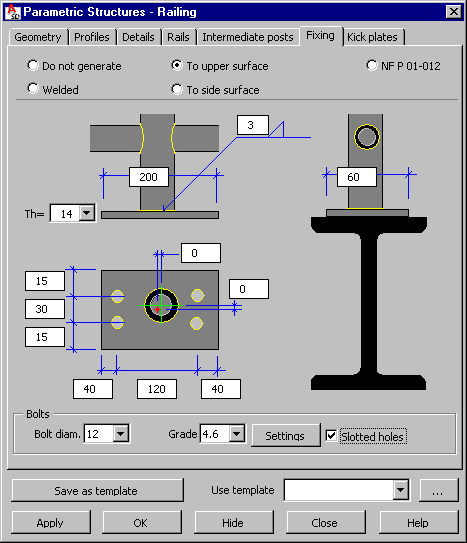
Posts may be joined to supporting elements selected while starting the Railing macro.
Select a fixing method:
- Do not generate – after you select this, connections with other structure elements are not generated and you are able to determine only a value of extension of posts below the zero level (a negative value of this parameter is treated as the shortening of posts).
- Welded – posts are cut to fit the supporting elements and welded to them using the site fillet welds of thickness you specify.
- To upper surface – posts are joined to supporting elements by a bolted connection (by an endplate of dimensions defined in the dialog). Endplates are aligned (facing operation) to the horizontal face of supporting elements; endplates are welded to posts by means of workshop welds.
- To side surface - posts are joined to supporting elements by a bolted connection (by a circular or rectangular endplate of dimensions defined in the dialog). Endplates are aligned (facing operation) to the vertical face of supporting elements; endplates are welded to posts by means of workshop welds. There are 2 possibilities, depending on the distance between the post and the face of a supporting profile:
- If distance D is less than (plate thickness + 0.2 in.), the plate is welded to the side face of a post, as shown.
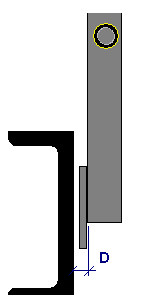
- If distance D is greater than (plate thickness + 0.2 in.), the post is supplemented with a horizontal element made of profile identical to the post profile. This element is welded to the post by means of workshop weld, as shown.
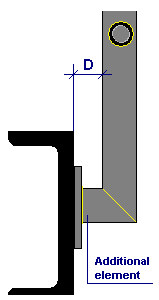
- If distance D is less than (plate thickness + 0.2 in.), the plate is welded to the side face of a post, as shown.
- NF P 01-012 – posts are trimmed according to the rules of the code NF P 01-012
- Rib - when you use this fixing method, posts are connected (by means of bolts) to the rib that is welded to the supporting bar. This fixing type can be applied only when the shape (I-sections or C-sections) and the position of the supporting bar make it possible to create the rib. The rib is always connected with the web of the profile of the supporting bar.
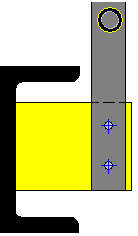
- Angle (internal) - when you use this fixing method, posts are connected with the profile of the supporting bar by means of an angle that is fixed with bolts to the web of the supporting bar. This fixing type can be applied only when the shape (I-sections or C-sections) and the position of the supporting bar make it possible to place the angle. The angle is always connected with the web of the profile of the supporting bar.Angles may be set 'before', 'behind', or on both sides of the post in relation to the initially defined polyline.

- Angle (external) - when you use this fixing method, posts are connected with the profile of the supporting bar by means of an angle that is welded to the external edges of the supporting bar. This fixing type can be applied with every type of profile of the supporting bar, and the angle can be welded to flanges and to any other surface of the supporting profile. Angles may be set 'before', 'behind', or on both sides of the post in relation to the initially defined polyline.
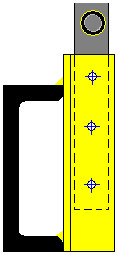
- Plate - when you use this fixing method, posts are connected with the profile of the supporting bar by means of a plate welded both to the post and to the supporting profile. This fixing type can be applied with every type of profile of the supporting bar, and the plate can be welded to flanges and to any other surface of the supporting profile.
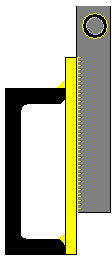
Under Bolts, specify the bolt diameter and grade (the options are available for the last Angle and Plate fixing types). Click Settings to open the Bolt settings dialog.
After you finish defining the details of joining the railing to structure elements, click the Kick plates tab to display the Railing – Kick plates dialog.